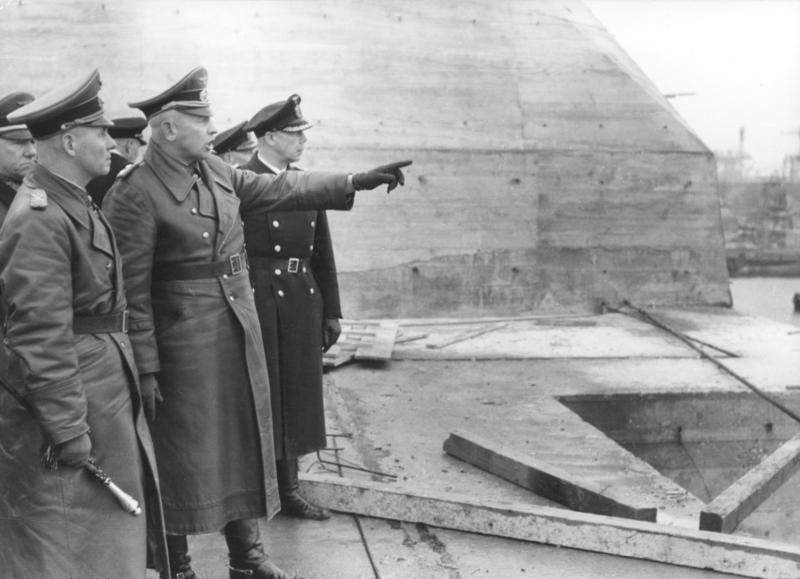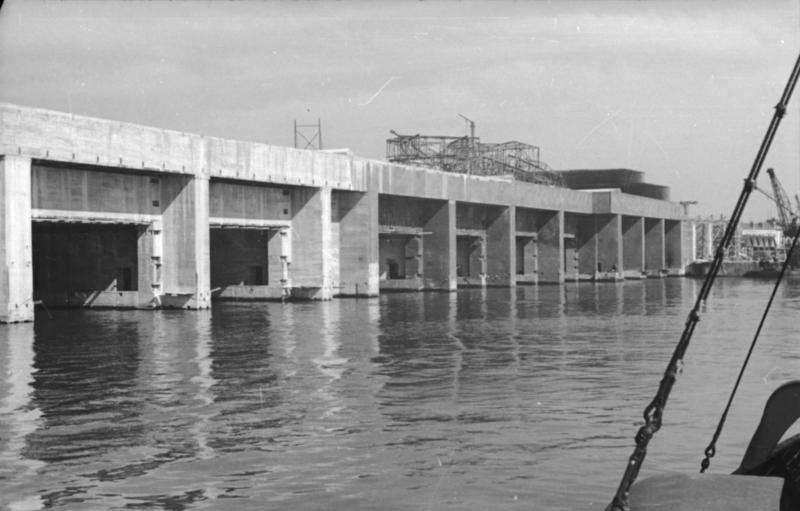The Saint-Nazaire submarine base was built in occupied France during The Second World War and stands as a testament to German engineering and strategic planning.
Constructed as one of the five large fortified U-boat pens, the base played a pivotal role in Germany’s naval operations in the Atlantic.
Contents
- Construction of the Submarine Base
- Architectural Features of the Submarine Base
- German Sub Base in France
- Historical Significance
- Operation Chariot
- After The War
- Conclusion
Construction of the Submarine Base
Situated in one of the largest harbors on the Atlantic coast of France, Saint-Nazaire became a strategic location for German submarine operations following Germany’s arrival in June 1940.
Recognizing the need for a secure facility invulnerable to air bombing from England, the German military began construction of the submarine base in February 1941.

Under the supervision of engineer Probst, the French boat building company Compagnie Générale Transatlantique’s docks and buildings were razed to make way for the submarine pens.
Read More Submarine Aircraft Carriers – The Japanese I-400 Class
The construction of the base took place in several phases. Pens 6, 7, and 8 were completed by June 1941, followed by the construction of pens 9 through 14 from July 1941 to January 1942. Pens 1 through 5 were added between February and June 1942.
To safeguard the submarines during their transfer from the Loire River, a fortified lock was built between late 1943 and early 1944.
Architectural Features of the Submarine Base
The Saint-Nazaire submarine base boasted impressive architectural design.
The dimensions of the base are as follows: 300 meters in length, 130 meters in width, and 18 meters in height. The base covered a vast surface area of 39,000 square meters.
The roof of the base is quite spectacular – measuring at 8 meters deep!

The roof consists of four layers. The first layer is 3.5 meters of reinforced concrete. The second layers is 35 cm of granite and concrete. The third layer is 1.7 meters of more reinforced concrete. And the fourth layer is 1.4 meters of ‘Fangrost’ steel beams.
The base also has a staggering volume of concrete, measuring a total of 480,000 cubic meters.
The base holds 14 submarine pens in total.
Pens 1 through to 8 are dry docks, measuring 92 meters long and 11 meters wide.
Read More USS Skate – The First Submarine To Surface At The North Pole
9 through to 14 are simple docks, measuring 62 meters long and 17 meters wide.
Each submarine pen could hold two submarines each.

The roof was equipped with anti-aircraft weapons, machine guns and mortars, but the exact strength and configuration of the defensive armament is unclear.
The base’s infrastructure was comprehensive, featuring workshops, magazines, offices, dormitories for submarine crews, pumps, kitchens, bakeries, electrical plants, a restaurant, and a hospital.
This self-sufficiency ensured efficient maintenance, repairs, and provisions for the submarines and their crews.
What Was The Major German Submarine Base In France?
The major German submarine base in France during World War II was the Lorient Submarine Base. The base was built by the German Kriegsmarine in 1941, and its expansion continued until 1943.
When Germany was defeated, the French Navy took it over and put it to use. It served its military purpose until 1995 when it was decommissioned and converted for civilian use.
Historical Significance
The submarine base of Saint-Nazaire played a significant role in German naval operations during World War II.
Its strategic location provided a stronghold for U-boat operations in the Atlantic, enabling Germany to disrupt Allied shipping convoys. The base became a high-priority target for the Allies due to its critical role in the German war effort.
Operation Chariot
On March 28, 1942, the dry-dock adjacent to the submarine base was the target of a daring Commando Raid.
Dubbed ‘Operation Chariot’, the raid sought to neutralize one of the few dry-docks large enough to house the mighty Tirpitz battleship.
Read More Fort Drum – The Concrete Battleship
The successful raid involved the use of the explosive-packed HMS Campbeltown, which was intentionally rammed into the dock gates.

Operation Chariot is a story that deserves its own article, and it is something we will cover here soon!
After The War
After World War II, the Allied forces were left with the question of what to do with such a heavily fortified and strategically placed installation. Despite their attempts, the allies found it too robust to be destroyed efficiently. The bunker was so well-constructed that demolition was deemed impractical due to the potential of widespread collateral damage and the enormous cost it would entail. As a result, the submarine base was essentially abandoned for many years.
In more recent decades, however, the Saint-Nazaire submarine base has been given new life as a cultural and historical site. From the late 20th century to the present day, parts of the base have been converted for civil use, including an exhibit about Saint-Nazaire during World War II, a cultural venue known as ‘Le Life’, an art space known as ‘Le VIP’, and even a skatepark.
The transformation of the Saint-Nazaire submarine base is an excellent example of how structures, originally constructed for war, can be repurposed for peace. Today, the base stands as a reminder of the city’s wartime past, while also serving as a hub for contemporary culture and history.
Conclusion
The submarine base of Saint-Nazaire stands as a testament to German engineering and strategic planning during World War II.
Its construction and architectural features exemplify the ingenuity and meticulousness employed by the Germans in establishing a formidable stronghold for U-boat operations.
The base’s historical significance lies in its pivotal role in Germany’s Atlantic naval strategy and its subsequent targeting by the Allied forces.
Today, the Saint-Nazaire submarine base serves as a reminder of the challenges faced by both sides during the war and the enduring legacy of their engineering feats.







